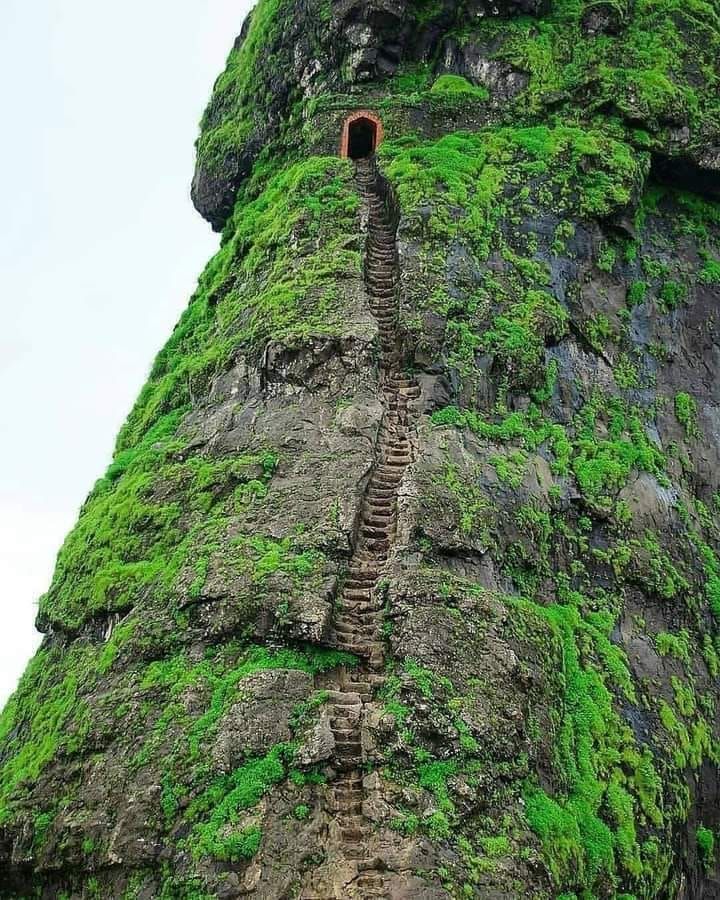Planning to trek Harihar Fort? Discover history, route details, difficulty, tips, and travel guide to make your adventure safe and memorable.
If you’re looking for an adventurous trek that challenges your courage yet rewards you with breathtaking views—Harihar Fort is the perfect destination.Have you ever wondered what it feels like to climb almost vertical rock-cut steps with the sky above and valleys beneath your feet? For many trekkers, Harihar is not just a trek; it’s a lifetime experience.
In this blog, we’ll cover everything about Harihar Fort—history, trekking route, difficulty level, best time to visit, safety tips, nearby attractions, and essential gear. By the end, you’ll know exactly how to plan your trip and make it unforgettable.
History of Harihar Fort
- Built during: The Yadava dynasty (9th–14th century).
- Strategic purpose: To guard the trade route connecting Maharashtra to Gujarat.
- Unique feature: Its triangular prism shape and vertical staircases carved directly into the rock.
- Later rulers: Controlled by the Bahamani Sultanate, Mughals, Marathas, and eventually the British.
Harihar isn’t just a trek—it’s a journey through history where courage meets architecture.
Why Harihar Fort is Famous
- Thrill factor: 80° steep rock-cut staircase with 200+ steps.
- Height: 3,676 feet (1,120 meters).
- Location: Nashik District, Maharashtra (Trimbakeshwar Range, Western Ghats).
- Adventure lovers’ hotspot: Every Instagram-worthy picture you see of trekkers climbing “impossible steps” is probably from Harihar.
Fun fact: Many trekkers say climbing down Harihar is scarier than going up!
Trekking Route to Harihar Fort
1. Base Village Options
- Nirgudpada Village (Harshewadi Route): Shorter and more popular (3–4 hours trek).
- Kotamvadi Village (Nirgudpada Route): Longer and less crowded (4–5 hours trek).
2. Difficulty Level
- Grade: Moderate to Difficult.
- Best for: Fit beginners (with guidance) and experienced trekkers.
- Key challenge: 200+ vertical steps carved into stone.
3. Trek Duration
- Ascent: 2–3 hours.
- Descent: 2–2.5 hours.
- Total time: 5–6 hours including breaks.
Best Time to Visit Harihar Fort
- Monsoon (July–September): Lush greenery, misty views, but slippery steps (not recommended for first-timers).
- Post-Monsoon/Winter (October–February): Best season—pleasant weather, clear skies, breathtaking landscapes.
- Summer (March–June): Avoid due to heat and dehydration risks.
Highlights of Harihar Trek
- The Vertical Steps – Heart-pounding, adrenaline-rush moment.
- The Stone Cut Caves & Water Tanks – Remains of the fort’s historic glory.
- Panoramic Views – Brahmagiri, Bhaskargad, and Utwad forts visible from the top.
- Sunrise & Sunset Views – Magical colors over the Sahyadris.
Essential Things to Carry
- Trekking Shoes: With good grip Buy Trekking Shoe
- Backpack: 20–30L with rain cover.
- Water: 2–3 liters minimum.
- Energy Snacks: Dry fruits, energy bars, ORS.
- Rain Gear: If trekking in monsoon.
- First Aid Kit: Band-aids, pain relief spray, basic medicines.
Safety Tips for Harihar Trek
- Always go with a group or local guide.
- Avoid monsoon if you’re a first-time trekker.
- Carry enough water & electrolytes.
- Descend carefully—the steps are steeper on the way down.
- Wear proper trekking shoes; sandals or sports shoes are risky.
If you’re planning your first trek to Harihar, it’s always better to go with an experienced team. At Durgaraj Institute, we organize guided treks across the Sahyadris, including Harihar, with proper safety, certified trek leaders, and local support.
My First Harihar Experience
I still remember my first Harihar trek. The base village was silent, with only the sound of birds and distant cowbells. But as soon as I stood at the bottom of the vertical rock staircase, my heart skipped a beat.
Each step felt like a decision—one wrong move and the valley would welcome me. But the top… oh, the top! The 360° view of green valleys and mountains made me forget the fear. Standing at the edge, I realized why trekkers call Harihar a once-in-a-lifetime climb.

How to Reach Harihar Fort
- Nearest City: Nashik (40 km).
- By Train: Igatpuri or Nashik Road Station, then taxi/bus to base village.
- By Road: From Mumbai (190 km, ~5 hours) or Pune (250 km, ~6 hours).
- Public Transport: State transport buses from Nashik to Trimbakeshwar, then shared jeeps.
Accommodation Options
- Camping: Allowed near base villages.
- Homestays: Simple village stays available .
- Hotels: Stay in Nashik or Igatpuri for better comfort.
Nearby Attractions
- Trimbakeshwar Temple – One of the 12 Jyotirlingas.
- Anjaneri Fort – Birthplace of Lord Hanuman.
- Brahmagiri Hills – Source of River Godavari.
- Nashik Vineyards – Sula, York, Soma Vineyards.
FAQs About Harihar Fort Trek
Q1. Is Harihar trek safe?
Yes, but it requires caution, especially on the vertical steps. Beginners should go with a guide.
Q2. Can beginners do Harihar Fort trek?
Yes, if physically fit and mentally prepared for heights.
Q3. How many steps are there in Harihar Fort?
Around 200 steep rock-cut steps.
Q4. Do I need prior trekking experience?
Not mandatory, but basic fitness and no fear of heights help a lot.
Conclusion
Harihar Fort isn’t just another trek—it’s a test of courage, balance, and determination. The fort whispers stories of warriors, traders, and nature’s timeless beauty.
So, if you’ve been craving an adventure that combines history, thrill, and breathtaking views—pack your bags for Harihar!
Ready to challenge yourself at Harihar? Join Durgaraj Institute’s next Sahyadri Trek and experience the thrill with a safe, organized group.
👉 What do you think? Would you dare to climb those vertical steps? Share your thoughts in the comments!
